Four pedestrians lost their lives in April; all of these collisions occurred after Gov. Lamont ordered non-essential employees to stop reporting to the job site.
Two pedestrian crash victims were leaving their shifts when fatally struck. One had 37 years on the job. The other, six months. Both leave families behind. A third was killed while doing his job.
Isaac Alvarez, respected by his boss at the Bishop’s Corner McDonald’s where he worked for half a year, was killed on his way home from work. The 19 year-old Hartford resident could not have taken the bus, as his shift ended around 11 PM on April 9, and bus service in that part of town stopped well before then.
He declined rides from coworkers and opted to skateboard home. Though the official crash report notes that he was improperly using the roadway, one look at the sidewalks along this stretch of Route 44 will explain why he may have chosen to use the far right portion of the far right lane instead of the sidewalk. Maybe he assumed there would be less traffic to worry about, especially at that time of night. If you have ever walked in the Albany Avenue area of West Hartford at night, you know how dark it is. He was hit from behind, just after 11 PM. The 53 year-old driver of a 2017 Toyota Highlander LE decided to not stop. A jogger found his body after seven the following morning. Isaac’s belongings were scattered in the roadway and the vicinity. Parts from the Toyota were found on the scene. He leaves a 2 year-old child and a newborn. His mother, on a funeral fundraiser page, wrote “He was such an amazing father to his 2 little ones. He was such a humble, loving, caring son. […] [M]y son had so many dreams….”
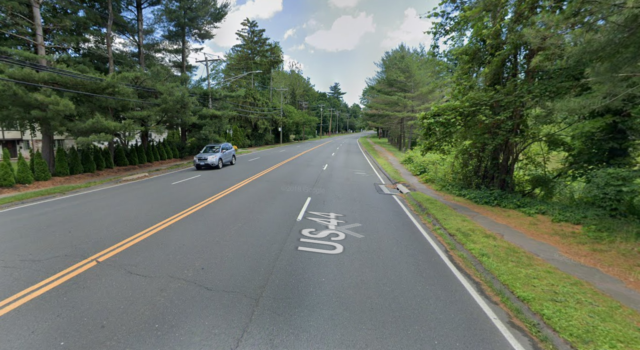
Ralph L. Lopardo, 60, of Waterford was struck and killed at 10:08 PM right after getting off his shift at EB in Groton. On April 21, Lopardo was in the crosswalk when he was hit by a 2012 Ford Focus driven by 37 year-old Carrie Malarkey. The Day reports that Lopardo “worked as a senior engineer for Knolls Atomic Power Laboratory out of the Electric Boat shipyard for 37 years, according to his family. He was married to his wife for 12 years and had a son, daughter, stepson and two grandchildren.” Charges have not yet been filed against the driver.
According to his obituary: “Ralph was a diehard NASCAR, Red Sox, Patriots fan, and avid golfer. He was a talented guitar player with a passionate love of music, including attending concerts and musicals. He loved summer vacationing at Hampton Beach, N.H. and hiking during the fall in the White Mountains, N.H. His greatest joy and pride in life was spending time with his family whom he deeply loved.”
Following his death — which came weeks after two EB workers were struck by cars around noon in New London — EB’s president issued a statement reminding pedestrians and drivers to be cautious, but offered nothing about what Electric Boat might do to improve safety for employees walking to their cars or taking a lunchtime stroll.
Most recently, on April 22 around 4:30 PM, Corey John Iodice was killed while on the job. The 58 year-old tow truck driver from Florida — formerly of the area and helping out with the family business — was struck and killed while he wore reflective clothing. This happened on the grassy shoulder of the Merritt Parkway in Trumbull. He was standing next to the tow truck and in the process of loading a disabled vehicle onto its flatbed. There was an additional car parked nearby. Between the number of vehicles and the reflective vest — in the middle of the day when there was not a raindrop in sight — it’s hard to understand how somebody could not see what was ahead. A Weston man, for reasons to be determined, drove his BMW off the roadway, striking the two cars, continued onto the flatbed, hitting and killing Iodice.
Having worked in this field for his whole life, the victim was no amateur. According to his obituary, Iodice “was a lifelong towing and recovery specialist who was well respected for his abilities to execute any recovery regardless of the circumstances. He was an anomaly in the towing industry and a consummate professional who was widely known as the guy who made safety his top priority. Corey took pride in working side by side with his brother Chris and their father Russ, during countless emergency situations for the Fairfield Police and Fire Services.”
According to his obituary, the victim also had a life outside of his work: “In 1991 [he and a family member] were each awarded a Civilian Service Medal from the town of Fairfield for saving the life of a victim involved in a horrific crash on Interstate 95. In his free-time, Corey loved the outdoors and enjoyed camping, hiking and biking. He is survived by his father, Russell, his siblings Robin, Cynthia (Connie), Keith, Christopher (Kristin) and Patricia. He will also be missed by his nieces, Kathryn, Jayme and Maddy, his nephew Roger and great-niece Elizabeth. He was predeceased by his paternal grandparents, Michael (Mickey) and Julia Iodice, maternal grandparents, Steven and Elizabeth Tupy, step-grandfather Adam Komosinski, mother Patricia, brother Brian and his dog Dude, his loyal companion.”
Those three were essential workers, just trying to do their jobs or get home at the end of the day. There was one other pedestrian killed in April.
A 31-year old New Haven man, Anthony Little, was killed on April 4th after being struck by two vehicles around 8 PM. One driver fled; the other remained on scene. While driving, Little realized he had left a tablet on the roof of his car. He pulled over and got out to retrieve it from the roadway. According to WFSB “Police used a license plate that had fallen in the road to track down the driver of the second vehicle. That driver is also now cooperating with police.”
As of publication, there has been no information about any of those drivers facing charges, even though the vulnerable user law could easily be applied in half of them with only the information available to the public.
I began this month hopeful that we would have zero pedestrian fatalities in Connecticut. That’s not hope I typically have, but with Gov. Lamont’s executive order issued at the end of March, it seemed like fewer people would be on the roads, and with non-stop worries about health, one would expect that everyone would be on their best behavior, acting with more caution around others.
Besides these four losses, there were many others: a total of 18 motor vehicle fatalities in April. That breaks down to fourteen drivers and passengers and four pedestrians; two of those fatal crashes were in Hartford. A number is nothing without a comparison, so here it is: there were ten motor vehicle fatalities in April 2019 in Connecticut. That is an 80% increase. How, you ask, were there more deadly crashes during a time of quarantine, when fewer people were on the roadways? How have there been more preventable deaths at a time when every news story is about health?
We should be extending our care for one another, but when people are unwilling to modify personal behaviors for the sake of safety, then we need to look at safer road designs and laws that don’t privilege the convenience and speed of some over the lives of others.
We don’t even need to remake the wheel — others have already done the work on figuring out safer streets. For places where budgets are tight (everywhere), tactical urbanism is an option. These are relatively inexpensive experiments to get information: does a treatment work at this location, does the community support it, are there any problems with the design that can be modified before a more costly and permanent fix is adopted?
Again, this is nothing new, though it is only starting to gain traction in Hartford. We saw two temporary installments last year on Prospect Street and at the intersection of Main Street and Charter Oak Avenue. Right now on Jefferson Street, we are seeing one travel lane removed, temporarily; it is reserved for those going to Hartford Hospital’s COVID-19 test station. One could see the opportunity here: later, after the virus crisis, turn this into a protected bicycle lane. Do so with the understanding that if an outdoor test station is required again, the hospital can reclaim use of the lane for the outbreak’s duration.
There is no radical thinking here. It’s simply being creative, flexible, and attuned to the needs of the time.
Another place we have seen flexibility is in Hartford’s move to automate a handful of pedestrian signals in the city, so that people do not have to unnecessarily touch a public surface at a time when we are all being told to minimize such contacts. Because we had some success here, advocates asked if Albany Avenue — Route 44 — could also automate the pedestrian signals. This had to go to the CT DOT, rather than Hartford’s DPW, because it is a state road that has been designed to move cars at the expense of everything else. This request for a temporary change that would benefit pedestrians during the pandemic was met with this response:
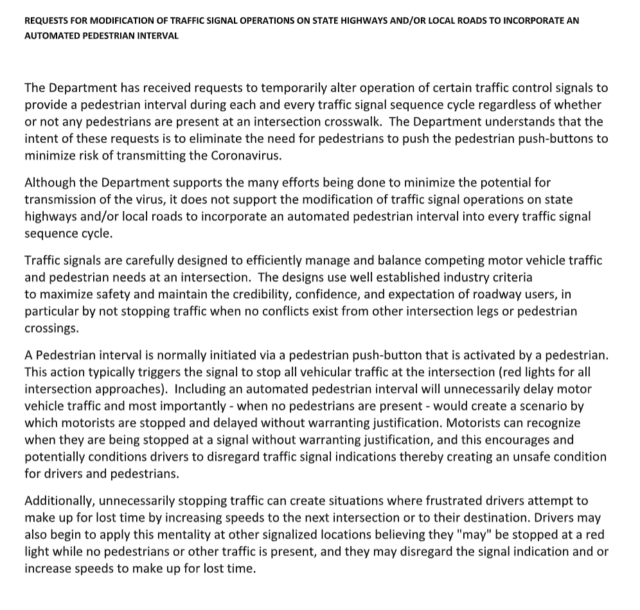
At a time when everyone has been asked to bend, the DOT stiffened.
It’s time engineers were trained in nuance so they can distinguish densely populated state roads from the other kind of highway. There are no houses facing interstates, yet there are homes, businesses, libraries, and houses of worship along Route 44, whether we are talking Hartford, West Hartford, or beyond.
While we are thinking concrete examples, we can keep talking about Albany Avenue, but let’s move west of the city line and zoom in on two locations: where Alvarez was struck and the area near where he had been working. After all, since 2015 the West Hartford section of Route 44 has been the site of at least 171 crashes with injuries, three of which have been fatal; that is upwards of 450 people directly impacted, physically.
Albany Avenue from Prospect Avenue to Steele Road currently has narrow sidewalks — when there are sidewalks at all. Riding a skateboard or bike on the sidewalk, then, is not really an option. There are no marked crosswalks between Prospect Avenue and Steele Road. That’s half a mile.
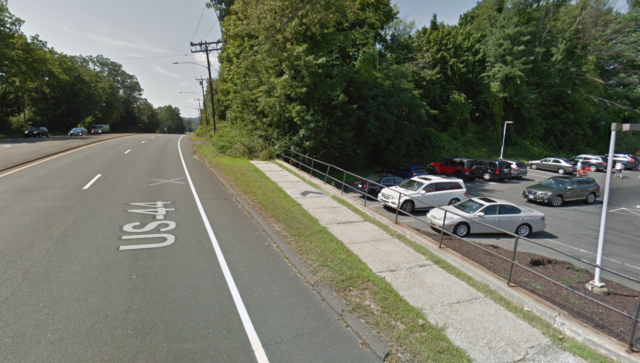
As for Bishop’s Corner, this area could be improved to fulfill the needs of multiple types of road users, from those walking to synagogue to biking over for groceries at The Crown to store employees waiting for their buses to those driving over the mountain to work downtown. If you hoped to walk from Bishops Place — boutique apartments — to Beth El, you would need to balance on a narrow strip of grass alongside speeding cars. At times, that pathetic space is reduced by the presence of a “No Parking” sign. The intersection of Albany Avenue and North Main Street is intimidating on foot. Though there are marked crosswalks and pedestrian signals here, there are many lanes and the requirement that one trust those barreling down the mountain will stop in time.
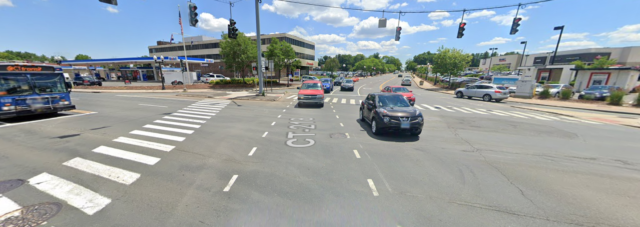
West Hartford is great for recreation, but lousy for commuting. There are sidewalks that just end here and on other roads, like Asylum Avenue. As Smart Growth America puts it — and this is an absolute no-brainer — “Pedestrian crashes are more than twice as likely to occur in places without sidewalks; streets with sidewalks on both sides have the fewest crashes.” Install those sidewalks! They need to be continuous and wide enough to accommodate those using mobility devices like wheelchairs. Speaking of accommodations, take a look at the bus stops. This one is right next to Saint Mary Home.
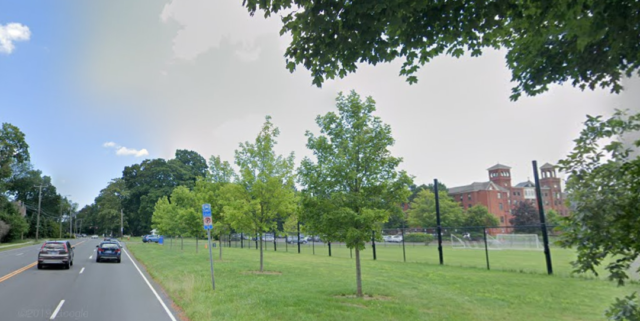
Another obvious change: lower the speed limit and make it more difficult for people to travel at life-threatening speeds. The U.S. Department of Transportation’s National Highway Traffic Safety Administration understands this, so surely our state can as well: “Speed reduction has a dramatic impact on pedestrian fatalities. 80 percent of pedestrians struck by a car going 40 mph will die; at 30 mph the likelihood of death is 40 percent. At 20 mph, the fatality rate drops to just 5 percent.” Where Alvarez was likely struck, the posted speed limit was 40 mph, with it changing to 30 mph just past the crash site; the driver should have already seen the giant yellow sign warning of the lower speed limit approaching, and should have reduced her speed. Considering how many people live along Albany Avenue, it seems reasonable to have 30 mph as the default speed limit, reserving higher speeds for areas without homes or businesses in close proximity.

Refuge islands would also help. Look at how these have improved Farmington Avenue in Hartford. With these additions, the road feels more balanced: bicycle lane, motor vehicle lane, raised median. Rather than experience very long waits or stand on the double yellow, people have a safer, more visible island to pause on while awaiting a break in traffic to cross on foot.
Better, pedestrian-scale lighting is needed for the corridor, and raised intersections would slow vehicles.
In its Complete Streets manual, the City of New Haven explains the purpose of this policy: “we intend to alter the balance of power in ways that impress upon users that the street has many purposes and is not simply a travel corridor dedicated exclusively to motor vehicle traffic. At the same time, we can improve the driving environment for motorists by encouraging more cooperative sharing from pedestrians and cyclists, improving the quality of travel through the reduction of unwarranted stops, and smoothing flow in a way that lowers stress and anxiety while encouraging slower and safer travel speeds.” The Town of West Hartford has adopted a Complete Streets policy of its own.
It’s easy to pick on West Hartford, but if we look at the map showing all pedestrian fatalities in 2020, most of the other crash sites could use design improvements, from roundabouts to protected bike lanes to centerline yield signs. The solutions are not one size fits all.
Are we going to be a society that understands how to improve safety for others and acts on that, or will we decide that others’ lives are not worth saving when it means causing a little inconvenience for motorists?
Top photo: One travel lane on Jefferson Street near Hartford Hospital has been temporarily closed to thru-traffic, with its use reserved for those driving to the virus test station. In it, you can see one of the pedestrian beg buttons that has been converted to automated service for the duration of the pandemic.
Other photos: screenshots of Google Maps showing various segments of West Hartford’s portion of Route 44/Albany Avenue. The first one captures the area where one pedestrian lost is life in April 2020.
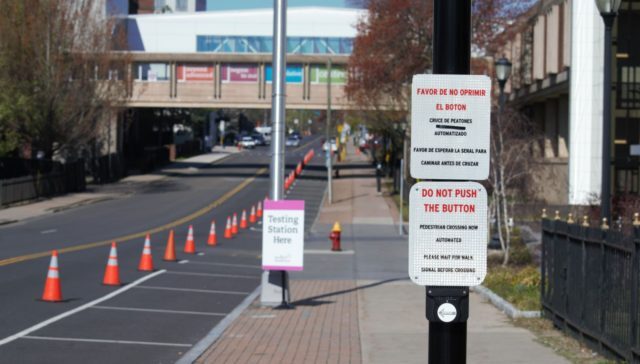

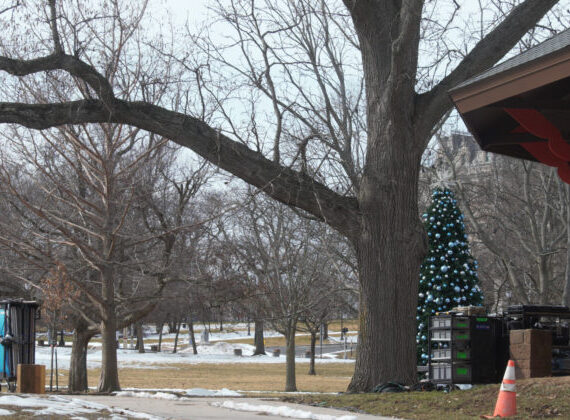
Linda Pagani
Thanks for this comprehensive and heartbreaking article. These innocent lives were lost why, because the state and municipalities refuse to adopt and enforce meaningful Complete Streets policies? Because the rights of motor vehicle drivers/owners supersede all others, including our right to live? The lack of pedestrian-safe roadways in our state is appalling and unconscionable. The DOT’s response is shameful, but not surprising. This is all unacceptable, and legions of citizens must demand immediate legislative change on a statewide and municipal level. Without that, it’s hard to change.
Andrew Lopez
Ditto Linda’s comment. Kerri, this article is amazing and heartbreaking and inspiring. Beautifully written and well-researched!